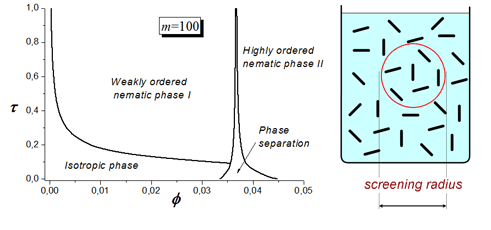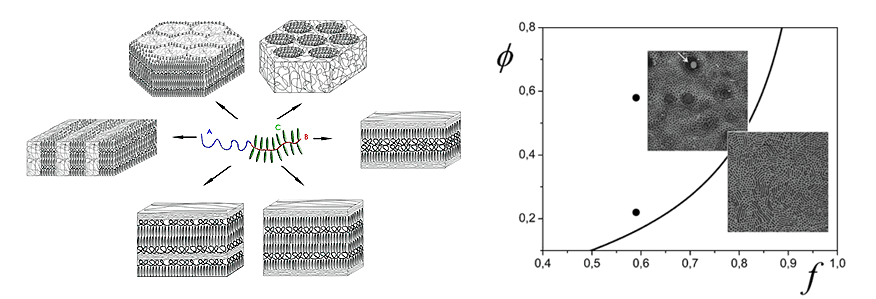liquid crystals back
back
Substance in the liquid-crystalline (LC) state stay in range between conventional liquid and crystalline solid body. Similar to liquids they characterized by absence of true long-range translational order. But due to the fact that all molecules still maintain long-range orientation order LC phase is anisotropic like crystalline solids.
Liquid crystalline polyelectrolytes
 The role of electrostatic interactions on liquid crystalline ordering of polymers has been discussed since famous papers by Onsager. Most of the theories are based on the mean-field approximation considering pairwise Coulomb interactions between macromolecules and leading to renormalization of the second virial coefficient. We have proposed another approach treating LC polyelectrolytes and counterions as multi-component plasma (Debye-Huckel-like approach), i.e., many-body interactions of all charged species were taken into account [1-4]. As a result, we have predicted orienting action of the electrostatic forces and possibility of weak nematic ordering even in dilute solutions [2]. The increase of polymer concentration results in transition from the weakly to strongly ordered nematic phase (see Figure) which is also stabilized by the excluded volume interactions.
The role of electrostatic interactions on liquid crystalline ordering of polymers has been discussed since famous papers by Onsager. Most of the theories are based on the mean-field approximation considering pairwise Coulomb interactions between macromolecules and leading to renormalization of the second virial coefficient. We have proposed another approach treating LC polyelectrolytes and counterions as multi-component plasma (Debye-Huckel-like approach), i.e., many-body interactions of all charged species were taken into account [1-4]. As a result, we have predicted orienting action of the electrostatic forces and possibility of weak nematic ordering even in dilute solutions [2]. The increase of polymer concentration results in transition from the weakly to strongly ordered nematic phase (see Figure) which is also stabilized by the excluded volume interactions.

Polymer films of block copolymers with liquid crystalline groups
 Investigations in that field demonstrated that decoration of diblock copolymers by LC ligands attached to one of the blocks may help resolve the problem of perpendicular orientation of domains in diblock copolymer films. It was shown that LC ligands improves stability of perpendicularly oriented domains which are either amorphous or liquid crystalline [5]
Investigations in that field demonstrated that decoration of diblock copolymers by LC ligands attached to one of the blocks may help resolve the problem of perpendicular orientation of domains in diblock copolymer films. It was shown that LC ligands improves stability of perpendicularly oriented domains which are either amorphous or liquid crystalline [5]

Possible nanodomain structures of diblock copolymers with LC side groups. Comparison of the theory with experimental data.